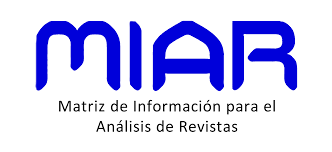Pathophysiology of interatrial block and its role as a predictor of supraventricular arrhythmias
Keywords:
Interatrial block, atrial arrhythmias, atrial fibrillation, atrial fibrosisAbstract
Interatrial block (IAB) can serve as a valuable electrocardiographic marker to assess the risk of developing atrial arrhythmias, and new onset of atrial fibrillation (AF). The IAB is produced by a deterioration in atrial conduction that implies a delay in the conduction of the electrical stimulus from the right atrium to the left atrium. Probable causes of Bachmann bundle interruption include ischemia, degenerative disease of aging, infiltrative diseases, diffuse coronary disease, and inflammatory conditions. The risk factors for advanced IAB, atrial fibrillation (AF), and cerebrovascular accident (CVA) appear to be very similar, and the underlying pathogenesis is probably due to myocardial fibrosis, and atrial remodeling. The interatrial block is clinically related to the appearance of supraventricular tachyarrhythmias and is related to atrial remodeling. Although atrial enlargement and IAB share a similar electrocardiographic pattern, they are separate entities. However, many authors still associate P wave duration greater than 120 ms with left atrial enlargement. Atrial remodeling modifies conduction velocity, cardiac architecture, voltage-gated ion channels, and resistance and capacitance components, such as the extracellular space and cell junctions. The alteration of these properties affects the electrophysiological properties of atrial conduction and favors IAB, atrial disorders, and the genesis of AF.
Downloads
References
Enriquez A, Conde D, Femenia F, De Luna AB, Ribeiro A, Muratore C, et al. Relation of interatrial block to new-onset atrial fibrillation in patients with Chagas cardiomyopathy and implantable cardioverter-defibrillators. Am J Cardiol. 2014; 113 (10): 1740-3. https://doi.org/10.1016/j.amjcard.2014.02.036
Jairath UC, Spodick DH. Exceptional prevalence of interatrial block in a general hospital population. Clin Cardiol. 2001;24(8):548-50.
Baranchuk A, Parfrey B, Lim L, Morriello F, Simpson C, Hopman WM, et al. Interatrial block in patients with obstructive sleep apnea. Cardiol J. 2011; 18: 171-5.
Jaén EG, Rodríguez PC, Solís LS, Trung CP, Jiménez Sánchez D, Sánchez García M, et al. Síndrome de Bayés en cirugía cardiaca: prevalencia de bloqueo interauricular en menores de 65 años sometidos a cirugía cardiaca y su asociación con fibrilación auricular en el postoperatorio. Arch Cardiol Mex. 2018;88(5):369-75. https://doi.org/10.1016/j.acmx.2017.09.004
Enriquez A, Sarrias A, Villuendas R, Ali FS, Conde D, Hopman WM, et al. New-onset atrial fibrillation after cavotricuspid isthmus ablation: Identification of advanced interatrial block is key. Europace. 2015; 17(8): 1289-93.
Istolahti T, Eranti A, Huhtala H, Lyytikäinen LP, Kähönen M, Lehtimäki T, et al. The prevalence and prognostic significance of interatrial block in the general population. Ann Med. 2020; 52 (3-4): 63-73. https://doi.org/10.1080/07853890.2020.1731759
Ciuffo L, Bruña V, Martínez-Sellés M, Doria de Vasconcellos H, Tao S, Zghaib T, et al. Association Between Interatrial Block, Left Atrial Fibrosis and Mechanical Dyssynchrony: Electrocardiography-Magnetic Resonance Imaging Correlation. J Cardiovasc Electrophysiol. 2020 Jul; 31(7): 1719-25. https://doi.org/10.1111/jce.14608
Jacinto ML, Ricaño M, Juárez V. Bloqueo interatrial (síndrome de Bayés). Ann Med. 2019; 64(1):35-42.
Tse G, Wong CW, Gong M, Wong WT, Bazoukis G, Wong SH, et al. International Health Informatics Study (IHIS) Network. Predictive value of inter-atrial block for new onset or recurrent atrial fibrillation: A systematic review and meta-analysis. Int J Cardiol 2018; 250: 152-6. https://doi.org/10.1016/j.ijcard.2017.09.176
Conde D, Seoane L, Gysel M, Mitrione S, Bayés De Luna A. Baranchuk Bayés’ syndrome: The association between interatrial block and supraventricular arrhythmias. Expert Rev Cardiovasc Ther. 2015;13(5):541-50.
Centurión OA, Isomoto S, Fukatani M, Shimizu A, Konoe A, Tanigawa M, et al. Relationship between atrial conduction defects and fractionated atrial endocardial electrograms in patients with sick sinus syndrome. PACE 1993; 16: 2022-33.
Centurión OA, Fukatani M, Konoe A, Tanigawa M, Shimizu A, Isomoto S, et al. Electrophysiological abnormalities of the atrial muscle in patients with sinus node Dysfunction without tachy arrhythmias. Int J Cardiol 1992; 37: 41-50.
Centurión OA, Shimizu A, Isomoto S, Konoe A, Kaibara M, Hayano M, et al. Influence of advancing age on fractionated right atrial endocardial electrograms. Am J Cardiol 2005; 96: 239-42. https://doi.org/10.1016/j.amjcard.2005.03.052
Centurión OA, Isomoto S, Shimizu A, Konoe A, Yano K. The effects of aging on atrial endocardial electrograms in patients with paroxysmal atrial fibrillation. Clin Cardiol 2003; 26: 435-8. https://doi.org/10.1002/clc.4960260911
Spach MS, Dober PC. Relating extracellular potentials and their derivatives to anisotropic propagation at microscopic level in human cardiac muscle. Evidence for electrical uncoupling of side-to-side fiber connections with increasing age. Circ Res. 1986;58(3):356-371.
Spach MS, Dober PC, Anderson PA. Multiple regional differences in cellular properties that regulate repolarization and contraction in the right atrium of adult and newborn dogs. Circ Res. 1989;65(6):1594-1611.
Sasaki N, Watanabe I, Okumura Y, Nagashima K, Kogawa R, Sonoda K, et al. Complex fractionated atrial electrograms, high dominant frequency regions, and left atrial voltages during sinus rhythm and atrial fibrillation. J Arrhythmia 2017; 33: 185-191.
García-Izquierdo Jaén E, Rodríguez PC, Solís LS, Trung CP, Sánchez DJ, García MS, et al. Bayes’ syndrome in cardiac surgery: Prevalence of interatrial block in patients younger than 65 years undergoing cardiac surgery and association with postoperative atrial fibrillation. Arch Cardiol Mex. 2018;88(5): 369-75.
Conde D, Seoane L, Gysel M, Mitrione S, Bayés De Luna A, Baranchuk A. Bayés’ syndrome: The association between interatrial block and supraventricular arrhythmias. Expert Rev Cardiovasc Ther. 2015;13(5): 541-50.
Tapanainen JM, Jurkko R, Holmqvist F, Husser D, Kongstad O. Interatrial right-to-left conduction in patients with paroxysmal atrial fibrillation. J Interv Card Electrophysiol. 2009;25: 117-22.
Tse G, Lai ETH, Yeo JM, Yan BP. Electrophysiological mechanisms of Bayés syndrome: Insights from clinical and mouse studies. Front Physiol. 2016; 7: 1-10.
Johner N, Namdar M, Shah DC. Intra- and interatrial conduction abnormalities: hemodynamic and arrhythmic significance. J Interv Card Electrophysiol. 2018; 52(3): 293-302.
Luna AB De, Platonov P, Cosio FG, Cygankiewicz I, Pastore C, Baranowski R, et al. Interatrial blocks. A separate entity from left atrial enlargement: a consensus report. J Electrocardiol. 2012; 45(5): 445-51. http://dx.doi.org/10.1016/j.jelectrocard.2012.06.029
Tse G, Wong CW, Gong M, Wong WT, Bazoukis G, Wong SH, et al. Predictive value of inter-atrial block for new onset or recurrent atrial fibrillation: A systematic review and meta-analysis. Int J Cardiol. 2018; 250: 152-6.
Enriquez A, Conde D, Hopman W, Mondragon I, Chiale PA, de Luna AB, et al. Advanced interatrial block is associated with recurrence of atrial fibrillation post pharmacological cardioversion. Cardiovasc Ther. 2014; 32(2): 52-6.
Enriquez A, Conde D, Femenia F, De Luna AB, Ribeiro A, Muratore C, et al. Relation of interatrial block to new-onset atrial fibrillation in patients with Chagas cardiomyopathy and implantable cardioverter-defibrillators. Am J Cardiol [Internet]. 2014;113(10): 1740-3. http://dx.doi.org/10.1016/j.amjcard.2014.02.036
O’Neal WT, Kamel H, Zhang ZM, Chen LY, Alonso A, Soliman EZ. Advanced interatrial block and ischemic stroke: The atherosclerosis risk in communities study. Neurology. 2016; 87: 352-6.
Baranchuk A, Parfrey B, Lim L, Morriello F, Simpson C, Hopman WM, et al. Interatrial block in patients with obstructive sleep apnea. Cardiol J. 2011; 18: 171-5.
Conde D, Baranchuk A. Bloqueo interauricular como sustrato anatómico-eléctrico de arritmias supraventriculares : síndrome de Bayés. Arch Cardiol Mex. 2014; 84(1): 32-40.
Jacinto ML, Ricaño M, Juárez V. Bloqueo interatrial (síndrome de Bayés). An Med. 2019;64(1): 35-42.
Agarwal YK, Aronow WS, Levy JA, Spodick DH. Association of interatrial block with development of atrial fibrillation. Am J Cardiol 2003; 91: 882. https://doi.org/10.1016/S0002-9149(03)00027-4
O'Neal WT, Zhang ZM, Loehr LR, Chen LY, Alonso A, Soliman EZ. Electrocardiographic Advanced Interatrial Block and Atrial Fibrillation Risk in the General Population. Am J Cardiol 2016; 117: 1755-9.
Sadiqali F, Enriquez A, Conde D, Redfearn D, Michael K, Simpson C, et al. Advanced Interatrial Block Predicts New Onset Atrial Fibrillation in Patients with Severe Heart Failure and Cardiac Resynchronization Therapy. Ann Noninvasive Electrocardiol 2015; 20: 586-91. https://onlinelibrary.wiley.com/doi/epdf/10.1111/anec.12258
He J, Tse G, Korantzopoulos P, Letsas KP, Ali-Hasan-Al-Saegh S, Kamel H, et al. P-Wave Indices and Risk of Ischemic Stroke: A Systematic Review and Meta-Analysis. Stroke. 2017; 48: 2066-72. https://doi.org/10.1161/STROKEAHA.117.017293
Lorbar M, Levrault R, Phadke JG, Spodick DH. Interatrial block as a predictor of embolicstroke. Am J Cardiol 2005; 95: 667-68. https://doi.org/10.1016/j.amjcard.2004.10.059
Ariyarajah V, Puri P, Apiyasawat S, Spodick DH. Interatrial block: a novel risk factor for embolic stroke? Ann Noninvasive Electrocardiol 2007; 12: 15-20. https://doi.org/10.1111/j.1542-474X.2007.00133.x
Centurión OA. Role of interatrial block recognition: A closer look to the Bayés syndrome. J Atr Fibrillation 2019; 12(2):2246. https://doi.org/10.4022%2Fjafib.2246
Baranchuk A, Enriquez A, Antiperovitch P, Alexander B, Çinier G. Advanced interatrial block as a key marker for atrial fibrillation recurrence: Bayés’ syndrome. J Geriatr Cardiol. 2017; 14 (3):169-73. https://doi.org/10.11909/j.issn.1671-5411.2017.03.005
Ciuffo L, Inoue YY, Tao S, Gucuk Ipek E, Balouch M, Lima JAC, et al. Mechanical dyssynchrony of the left atrium during sinus rhythm is associated with history of stroke in patients with atrial fibrillation. Eur. Heart J. Cardiovasc. Imaging 2018; 19(4): 433-41. Doi: 10.11909/j.issn.1671-5411.2017.03.005
Baranchuk A, Yeung C. Advanced interatrial block predicts atrial fibrillation recurrence across different populations: Learning Bayes syndrome. Int. J. Cardiol 2018; 272: 221-2. https://doi.org/10.1016/j.ijcard.2018.08.025
Benito EM, De Luna AB, Baranchuk A, Mont L. Extensive atrial fibrosis assessed by late gadolinium enhancement cardiovascular magnetic resonance associated with advanced interatrial block electrocardiogram pattern. Europace 2017; 19(3): 377. https://doi.org/10.1093/europace/euw294
Lacalzada-Almeida J, Izquierdo-Gómez MM, Belleyo-Belkasem C, Barrio-Martínez P, García-Niebla J, Elosua R, et al. Interatrial block and atrial remodeling assessed using speckle tracking echocardiography. BMC Cardiovasc. Disord 2018; 18(1): 38. https://doi.org/10.1186/s12872-018-0776-6
Lacalzada-Almeida J, Izquierdo-Gómez MM, García-Niebla J, Elosua R, Jiménez-Sosa A, Baranchuk A, et al. Advanced interatrial block is a surrogate for left atrial strain reduction which predicts atrial fibrillation and stroke. Ann. Noninvasive Electrocardiol 2019: 24(4): e12632. https://doi.org/10.1111/anec.12632
Carrillo-Loza K, Baranchuk A, Serrano F, Hassebb S, Espinosa Lirac F, Soriano E, et al. El bloqueo interatrial avanzado predice recurrencia de infarto cerebral embólico de origen no determinado. Neurologia (Engl Ed) 2019; S0213-4853(19)30136-7. https://doi.org/10.1016/j.nrl.2019.10.007
Gentille-Lorente D, Salvadó-Usach T. Clinical, electrical and echocardiographic characteristics of patients with advanced interatrial block. Arch Cardiol Mex. 2021; 91(1): 135-8. https://doi.org/10.24875/ACM.20000239
Bisbal F, Baranchuk A, Braunwald E, Bayés de Luna A, Bayés-Genís A. Atrial failure as a clinical entity. JACC Review Topic of the Week. J Am Coll Cardiol. 2020; 75(2): 222-32. https://doi.org/10.1016/j.jacc.2019.11.013
Skov MW, Ghouse J, Kuhl JT, Pyotr G, Platonov PG, Graff C, Fuchs A, et al. Risk Prediction of Atrial Fibrillation Based on Electrocardiographic Interatrial Block J Am Heart Assoc. 2018;7: e008247. https://www.ahajournals.org/doi/10.1161/JAHA.117.008247
Vicent L, Fernandez-Cordon C, Nombela-Franco L, Escobar-Robledo LA, Ayesta A, Sole A, et al. Baseline ECG and Prognosis After Transcatheter Aortic Valve Implantation: The Role of Interatrial Block. J Am Heart Assoc. 2020; 9: e017624. https://www.ahajournals.org/doi/10.1161/JAHA.120.017624
Falcón RDP, Zapattini DH, Scavenius KE, Meza AJ, Galeano EJ, Centurión OA. Rol del bloqueo interauricular avanzado en la predicción de accidentes cerebrovasculares isquémicos. Mem. Inst. Investig. Cienc. Salud. 2021; 19(3): 105-114.
Falcón RDP, Centurión OA, Meza AJ, Scavenius KE, Chavez CO, Montiel CR, García LB, Cáceres C, Martinez JE, Galeano JE. Role of the electrocardiographic MVP risk score (Morphology-Voltage-P wave duration) in predictin the development of atrial fibrillation in patients with systemic arterial hypertension. Crit Pathw Cardiol. 2023 Aug 4. https://doi.org/10.1097/hpc.0000000000000328














